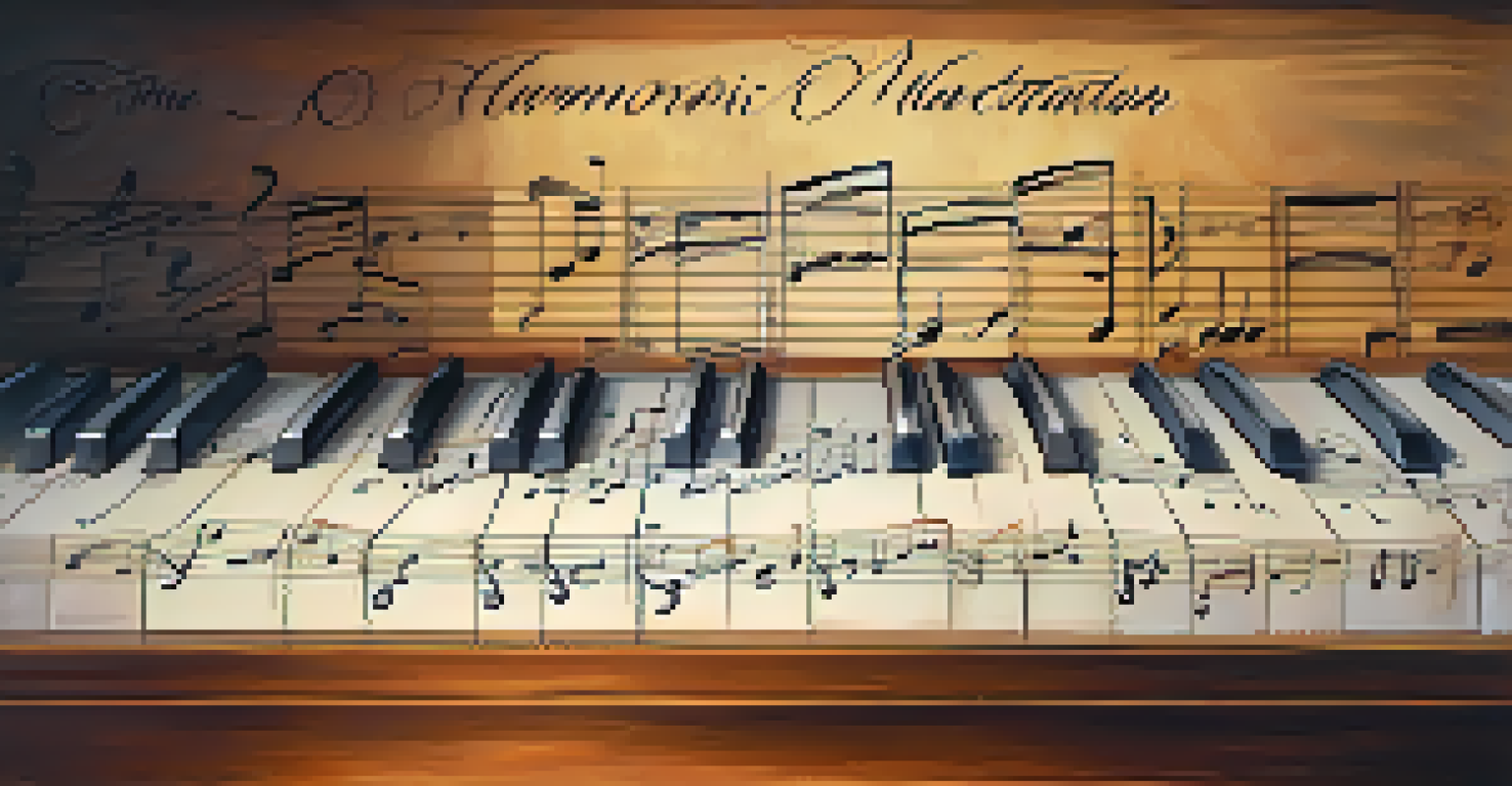Harmonic Minor Scale: Patterns and Melodic Insights

Understanding the Harmonic Minor Scale Basics
The harmonic minor scale is a fascinating musical structure that differs from the natural minor scale. Essentially, it features a raised seventh note, creating a unique tension that can lead into resolutions that are quite satisfying. This alteration gives the scale an exotic flair, making it popular in various genres, especially in classical and Middle Eastern music.
Music is the shorthand of emotion.
For instance, if we take the A natural minor scale (A, B, C, D, E, F, G) and raise the seventh note, we get the A harmonic minor scale (A, B, C, D, E, F, G#). This small change significantly impacts the scale's overall sound and feel, adding a dramatic twist that composers and musicians love to exploit.
Understanding this scale is crucial for musicians looking to expand their repertoire. It opens the door to new melodic and harmonic possibilities, allowing for richer compositions that can evoke deep emotions.
Exploring the Scale Patterns
Practicing scale patterns is an effective way to internalize the harmonic minor scale. A common approach is to run through various fingerings on your instrument, starting from different notes within the scale. This not only helps with technique but also familiarizes you with how the scale feels in different contexts.

One popular pattern involves playing the scale in thirds, which means playing every other note. For example, in A harmonic minor, this would be A, C, B, D, C, E, D, F, E, G#, F, A, and so on. Such patterns help in developing your ear and understanding how the notes interact melodically.
Harmonic Minor's Unique Sound
The harmonic minor scale features a raised seventh note, creating a distinctive tension that enhances emotional expression in music.
Incorporating these patterns into your daily practice can greatly enhance your improvisational skills. You’ll start to recognize how these notes can create tension and release, leading to more expressive playing.
Melodic Insights from the Harmonic Minor Scale
The harmonic minor scale isn't just about playing the right notes; it's about how you use them melodically. The raised seventh note often leads to a strong resolution back to the tonic, making it a powerful tool for composers. This tension-and-release dynamic is fundamental in creating memorable melodies.
The music is not in the notes, but in the silence between.
Musicians often employ this scale to evoke specific feelings, particularly in genres like flamenco, jazz, and classical music. For example, in flamenco guitar, the harmonic minor scale is a go-to for creating passionate and dramatic pieces that tell a story.
When composing or improvising, consider how the unique qualities of the harmonic minor scale can shape your melodies. Experiment with different rhythmic patterns and phrasing to see how they alter the emotional impact of your music.
The Role of the Harmonic Minor in Various Genres
The harmonic minor scale plays a significant role across a variety of music genres. In classical music, it’s often used to create dramatic contrasts and complex harmonies. Composers like Bach and Beethoven utilized this scale to add depth and emotion to their works.
In jazz, the harmonic minor scale is frequently used over minor chords, particularly in the context of the ii-V-I progression. Jazz musicians embrace its exotic sound to infuse their solos with creativity and flair, often bending notes and altering rhythms to enhance the scale's unique flavor.
Chords from Harmonic Minor Scale
Understanding the chords derived from the harmonic minor scale allows musicians to create rich harmonies and dynamic compositions.
Moreover, in various folk traditions around the world, the harmonic minor scale has become a staple. Its distinctive sound captures cultural narratives, making it an essential element in many traditional musical forms.
Chords Built from the Harmonic Minor Scale
Understanding the chords that can be built from the harmonic minor scale is crucial for any musician. The scale generates a variety of chords that can be used for accompaniment or as the foundation for improvisation. For instance, the A harmonic minor scale produces the chords A minor, B diminished, C augmented, and D minor.
The dominant seventh chord built on the fifth degree of the scale is particularly interesting. In A harmonic minor, this would be E7, which creates a strong pull back to the tonic, A minor. This characteristic makes it a powerful tool for creating tension in your compositions.
As you explore these chords, try playing them in different inversions and voicings. This experimentation will not only enhance your chordal playing but also expand your harmonic vocabulary, allowing for more dynamic musical expressions.
Exercises to Master the Harmonic Minor Scale
To truly master the harmonic minor scale, consistent practice is essential. Start with simple exercises, such as playing the scale ascending and descending, then gradually add variations. For example, try playing the scale in different rhythms or articulations to challenge yourself and deepen your understanding.
Another effective exercise is to create melodic lines using the harmonic minor scale. Set a timer for a few minutes and improvise melodies, focusing on the unique sound of the raised seventh note. This will help you internalize the scale while fostering your creativity.
Essential Exercises for Mastery
Consistent practice with scale variations and melodic improvisation is crucial for mastering the harmonic minor scale.
Finally, consider integrating the harmonic minor scale into your songwriting. Write a short piece or a solo section using this scale, paying attention to how the raised seventh influences your musical ideas. Engaging with the scale in this way will solidify your understanding and enhance your overall musicianship.
Conclusion: The Harmonic Minor Scale's Lasting Impact
The harmonic minor scale is more than just a collection of notes; it’s a pathway to emotional expression in music. Its distinctive sound evokes feelings of longing and drama, making it a valuable asset for any musician. Whether you're a composer, performer, or simply a music enthusiast, understanding this scale can deepen your appreciation for music.
By incorporating the harmonic minor scale into your practice, you open up a world of melodic and harmonic possibilities. The insights gained from exploring its patterns can enrich your playing and songwriting, fostering a deeper connection with the music you create.

In summary, the harmonic minor scale holds a special place in the musical landscape. Its versatility across genres and emotional depth make it a timeless element that musicians will continue to explore for generations to come.